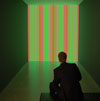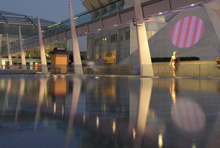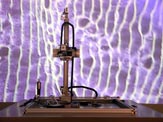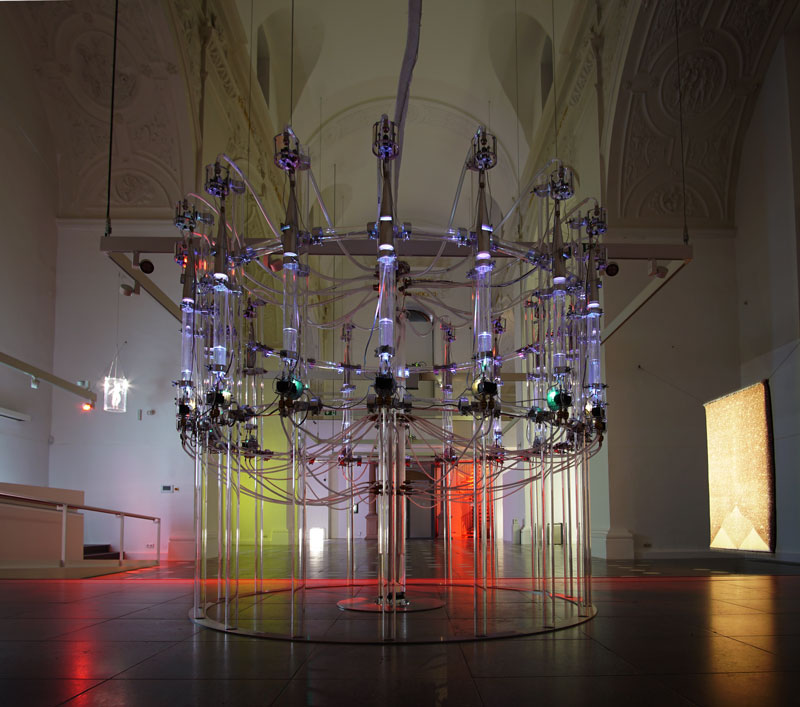-

 Cosmic Revelation
Karlsruhe (D) 2008 (D) - Stuttgart (D) 2016.
Cosmic Revelation
Karlsruhe (D) 2008 (D) - Stuttgart (D) 2016.
With huge light installations in a detector field of the Karlsruhe Institute of Technoloy or at the Aufstiege light art festival in Stuttgart Cosmic Revelation made the energies of cosmic rays visible originating from the depths of space and bombarding our planet's atmosphere. One or two times per seconds the cosmic energies revealed its existence in bright flashy moments. Oxford Professor Martin Kemp resumes in Nature: A new art is encoding a new science.(Nature 458, 836 [2009] ) -

 Coloursex
Oberhausen 2009 – Dresden 2010(D)
Coloursex
Oberhausen 2009 – Dresden 2010(D)
The self-organisation of colour is the core principle of Coloursex. Dots of transparent colour foil build a matrix of interacting colours which evolve line by line. Curator Konrad Scheurmann writes in occasion of the exhibition "Farbe materiell – Farbe immateriell" at Festspielhaus Hellerau in Dresden 2009: "The self-organisation of colour is at the heart of the 'Coloursex' cycle of works. [...] Colour notations, such as those developed by Paul Klee in his Kunstlehre (Art Theory) book, undergo a dynamic evolution of their own." -

 I see what I see not
Kunstfassade München (D), 2003/05.
I see what I see not
Kunstfassade München (D), 2003/05.
On invitation by Marion Ackermann the project I see what I see not was developed for the "Kunstfassade" in the heart of the city of Munich. Pixel by pixel astronomical pictures from the most objects in the universe were translated to the light panels of the media facade. The project was awarded in 2004 by the International Media Art Award by SWR & ZKM Karlsruhe. Jury member Prof. Horst Bredekamp resumes the project's special connection of art & science: A rhetoric of origins using visual means that defines origins not as an end, but as a potential for new openings. -

 Barroco
Deutsche Diamand- und Edelsteinbörse, Idar-Oberstein 2003.
Barroco
Deutsche Diamand- und Edelsteinbörse, Idar-Oberstein 2003.
A special interplay between near and far was performed by means of an extreme slide projection in occasion of the International Gemstone Trade Fair bringing arts and the monolith of the German Diamonds and Gemstone Bourse into a baroque-like dialogue of surfaces. In the barocco cycle the world of gemstonce were approached by exposing in a private gemstone collection the shadows of the precious stones directly on light sensitive slide film. -

 Heaven's Carousel
Rome (I) 2014 – Munich (D) 2025
Heaven's Carousel
Rome (I) 2014 – Munich (D) 2025
Roths's sonic laboratories turn space into a synthesizer or instrument: numerous individual custom designed speakers are arranged in a room to recompose their tones to specific local sounds by additive synthesis. The Heaven's Carousel adds a kinetic dimension putting 36 speakers into motion rotating with a span up to 15 meters above the audience. In occasion of the premiere 2014 in Rome Nobel laureate Adam Riess resumes in his opening speech: "This incredible dynamic sculpture created by Tim Otto Roth channels some of these feelings about the accelerating universe." -

 NATUR
Black Forest (D) since summer 2022
NATUR
Black Forest (D) since summer 2022
With NATUR a completely new type of art work premiered in summer 2022 oscillating between sculpture and land art. Each of the five letters erected on the Kleinebene hill at the Black Forest town of Oppenau is made from a different type of local timber connected by fitting joints. With the erection of the sculpture, is is handed over to the play of natural forces, thus transforming the letters into ecological sculpture. For Schirn director Sebastian Baden the 14 meter long sculpture "is an anthropologocial sign, a portent of the finiteness of the human species." -
![AIS³ [aiskju:b]](ais3/images/munich/ais3@reaktorhalle7448_800px.jpg)
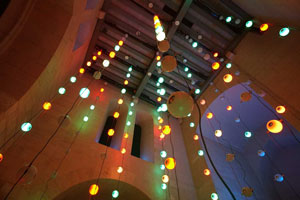 AIS³ [aiskju:b]
Berlin (D) 2018 – Innsbruck(A) 2025
AIS³ [aiskju:b]
Berlin (D) 2018 – Innsbruck(A) 2025
In the absolute darkness of the Arctic ice or the deep sea, researchers search for ultrashort light traces of neutrinos, also known as ghost particles. The recorded light movements serve as a "natural score" for the sound laboratory consisting of a cluster of up to individual 444 loudspeakers. The colour illumination indicating the played frequency turns the ensemble into a kind of electro acoustic music theatre. This leaves no one untouched, as curator Annabelle Görgen so aptly puts it in the AIS³ review: "as we resonate with AIS³ we experience not (only) processes taking place in space, but (also) ourselves." -

 Symphonia Galactea
Effelsberg (D) For this live onsite sound performance the world's second largest fully steerable radio telescope scanned in a slow, almost invisible zigzag course the Galactic plane of the Milky Way for 21cm radio emission. The resulting spectra of atomic hydrogen were translated for a circle of 16 speakers into a pulsating field of interfering microtonal tones. The effect of scanning was visually reenforced by a beam of a 7 Watt laser mounted in the primary focus of the telescope pointing to the observed sky region.
Symphonia Galactea
Effelsberg (D) For this live onsite sound performance the world's second largest fully steerable radio telescope scanned in a slow, almost invisible zigzag course the Galactic plane of the Milky Way for 21cm radio emission. The resulting spectra of atomic hydrogen were translated for a circle of 16 speakers into a pulsating field of interfering microtonal tones. The effect of scanning was visually reenforced by a beam of a 7 Watt laser mounted in the primary focus of the telescope pointing to the observed sky region.
-
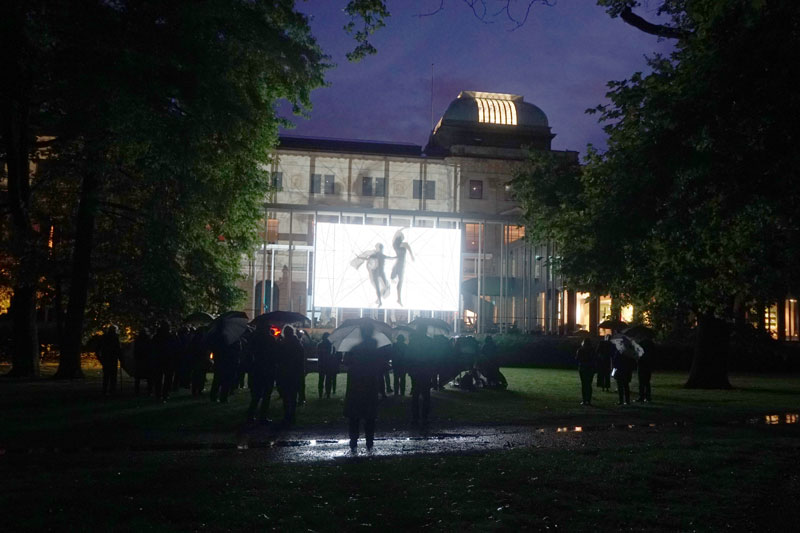
 sterea skia
Bad Rothenfelde (D) 2015 – Braunschweig (D) 2022
sterea skia
Bad Rothenfelde (D) 2015 – Braunschweig (D) 2022
In occasion of the Lichtsicht Biennale curated 2015 by Peter Weibel the first light took place for this series of computer aided anaglyphic shadow theater. The clue of the six channels video projections on the 100 meter long wall of the old gradation tower in Bad Rothenfelde is that the shadows turn into spatial impressions if you wear red/cyan glasses. Recent shadow choreographies for the Akademie der Künste in Berlin, the Kunsthalle Jesuitenkirche in Aschaffenburg or Herzog Anton Ulrich-Museum in Braunschweig push the idea further including also dance with the help of motion tracking. -

 100 Days - 100 Imachinations
Kassel (D) 2002 - Vienna 2008 (AT).
100 Days - 100 Imachinations
Kassel (D) 2002 - Vienna 2008 (AT).
For 100 days this series of daily abstract images appear via internet as projections parallel in various places around the globe: This visualization recall color field painting and the minimal light-based works of Dan Flavin. [...] It appears as a fluctuating wave pattern: the forms are produced by superimposing two wave patterns, whose color and scale change seemingly at random, but actually according to the numbers following the decimal point in the calculation of pi. What looks like an abstract pattern is an index of an unending process of mathematical calculation. (Laura Marks, Enfoldment and Infinity) -

 Pixelsex
KPN Telecom Tower, Rotterdam (NL), 2005/2006
Pixelsex
KPN Telecom Tower, Rotterdam (NL), 2005/2006
Pixelsex brought 'life' to the at that time world's largest light façade at the KPN Tower in Rotterdam built by Renzo Piano. The fight about life and death is visualized on the 80 m high façade in a minimalist manner by a so called cellular automaton, whereby the pixels – the single picture elements – do have sex with each other, new pixels are born and other pixels die. Pixelsex was realized in collaboration with the bio-modelling group at TU Dresden. -

 From the Distant Past
Venice (I) 2010 – New York City 2011
From the Distant Past
Venice (I) 2010 – New York City 2011
This first art & science cooperation with Hubble Space Telescope explores the frontiers of colour vision in astrophyscis. The green high power laser projection at the Istituto Veneto di Scienze, Lettere ed Arti in the heart of Venice shows a minimalist animated laser pulse – spectra from some of the most distant objects echoing the oldest colours in the Universe. In 2011 these 'heart beats' of the cosmos were projected with two lasers on the Haydn planetarium sphere of the Museum of Natural History in New York City. -

 Videoshadows
Frankfurt (D) 2002 - Kassel (D) 2003
Videoshadows
Frankfurt (D) 2002 - Kassel (D) 2003
The video shadows are a radical gesture removing the optics from a camera and exposing objects on the naked video chip. For the exhibition Leuchtspur of the MMK (Museum für Neue Kunst) Frankfurt the especially designed light robot was installed in a gangway at the historic town hall of Frankfurt and the imagery was backprojected into the window pane facing the "Römer". Art historian Dagmar Keultjes was impressed a year later by the presentation at the regional council of Kassel: a poetic, almost musical effect emerges, but the abstract phenomena remain enigmatic. -

 Switch Off
German Light Art Award LUX.US, Lüdenscheid (D) 2004
Switch Off
German Light Art Award LUX.US, Lüdenscheid (D) 2004
On the occasion of the German Light Art Award for his concept Switch Off Uwe Rüth wrote in the juries plea: To win a light award with an action centring the darkness implicates to render moot the whole light art and to disclose that light can't exist without darkness. -

 Memento 190
In summer 2014 a memorial in the Black Forest town Oppenau commemorating the soldiers killed during World War I was demolished to construct a parking. These circumstances were the motivation to initiate a temporary memorial in the artist's studio in the old station using an LED display bar scrolling through all the 190 names of the local war deads. This visual play with familiar train displays comprises more than an element of irritation, it is also a reference to the station as location, where a lot of soldiers said a finaly good-bye to their families.
Memento 190
In summer 2014 a memorial in the Black Forest town Oppenau commemorating the soldiers killed during World War I was demolished to construct a parking. These circumstances were the motivation to initiate a temporary memorial in the artist's studio in the old station using an LED display bar scrolling through all the 190 names of the local war deads. This visual play with familiar train displays comprises more than an element of irritation, it is also a reference to the station as location, where a lot of soldiers said a finaly good-bye to their families.
An interactive map on the project page indicates the dates and the locations of death, which could be reconstructed.
This jQuery slider was created with the free EasyRotator software from DWUser.com.
Use WordPress? The free EasyRotator for WordPress plugin lets you create beautiful WordPress sliders in seconds.
OK
Use WordPress? The free EasyRotator for WordPress plugin lets you create beautiful WordPress sliders in seconds.
OK

Heaven's Carousel |
|
|
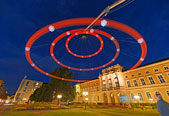 |
NATUR |
|
|
 |
[aiskju:b] |
|
|
 |
Symphonia Galactea |
|
|
 |
sterea skia |
 |
|
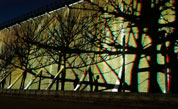 |
Little Bang Theory |
 |
|
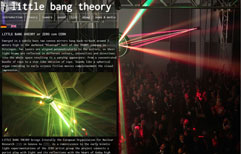 |
cosmic revelation |
 |
|
 |
memento 190 |
 |
|
 |
From The Distant Past |
 |
|
 |
Coloursex |
 |
|
 |
Pixelsex |
 |
|
|
100 Days - 100 Imachinations |
 |
|
|
I see what I see not |
 |
|
|
Switch Off |
 |
|
 |
ballet-photo-grammatique |
 |
|
|
barroco |
 |
|
|




